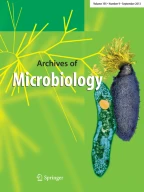Summary
A high temperature strain of the blue-green alga, Synechococcus lividus has been cultured and cloned in defined medium.
-
1.
S. lividus (Culture OH-68-s, Clone H-Xf) is an obligate thermophile with a temperature range of growth from 54 to 72°C. The optimal conditions for growth were at 63 to 67°C and a light intensity greater than 700 ft-c, resulting in a reproducible minimum generation time of 11 hours. Growth was depressed in the supra-optimal range from 68 to 72°C. The temperature characteristic or coefficient (μ) of growth was calculated as 13,750 cal mole-1. This value would not distinguish this organism from mesophilic and psychrophilic yeasts and bacteria.
-
2.
Clone H-Xf photosynthesized from as low as 33 to 75°C during short exposure times (20 min) without prior acclimation to the incubation temperatures. Longer exposures to the higher temperatures indicated that the “stable” upper limit for photosynthesis was 73°C when cells were grown above 60°C, but was only 70°C for cultures grown at 55 and 57°C.
-
3.
Abrupt shifts of exponential cultures between optimal (65°C) and near minimal (55°C) growth temperatures showed that lag periods occurred before normal growth commenced at the new temperatures. However, these lag periods on downward temperature shifts followed only after a period of residual growth. Similar shifts from optimal to subminimal (45°C) temperatures indicated that growth continued for a period of time before entering an extended stationary phase prior to senescence. Both of the latter types of experiments may indicate that products synthesized at 65°C are consumed by residual growth after the shifts to lower temperatures, but that these are replaced after a long delay (acclimation) at 55°C and not at all at 45°C.
-
4.
Photoincorporation of 14C−NaHCO3 was highly sensitive to subminimal temperatures after the first hour of exposure. The data suggest that the photosynthetic system could be involved in determining both the upper and lower limits of growth in this organism.
Similar content being viewed by others
References
Babel, W.: Der Effekt des abrupten Temperatur-„Shifts” auf die Vermehrung von Bacillus stearothermophilus. Z. allg. Mikrobiol. 9, 69–71 (1969).
Baig, I. A., Hopton, J. W.: Psychrophilic properties and the temperature characteristic of growth of bacteria. J. Bact. 100, 552–553 (1969).
Bausum, H. T., Matney, T. S.: Boundary between bacterial mesophilism and thermophilism. J. Bact. 90, 50–53 (1965).
Berns, D. S., Scott, E.: Protein aggregation in a thermophilic protein. Phycocyanin from Synechococcus lividus. Biochemistry 5, 1528–1533 (1966).
Brock, T. D.: Microorganisms adapted to high temperatures. Nature (Lond.) 214, 882–885 (1967a).
—: Life at high temperatures. Science 158, 1012–1019 (1967b).
—, Brock, M. L.: Measurements of steady-state growth rates of a thermophilic alga directly in nature. J. Bact. 95, 811–815 (1968).
—, Darland, G. K.: Limits of microbial existence: temperature and pH. Science 169, 1316–1318 (1970).
Bott, T. L., Brock, T. D.: Bacterial growth rates at high temperatures above 90°C in Yellowstone hot springs. Science 164, 1411–1412 (1969).
Castenholz, R. W.: The behavior of Oscillatoria terebriformis in hot springs. J. Phycol. 4, 132–139 (1968).
—: Thermophilic blue-green algae and the thermal environment. Bact. Rev. 33, 476–504 (1969).
—: Laboratory culture of thermophilic Cyanophytes. Schweiz. Z. Hydrol. 32, 538–551 (1970).
Castenholz, R. W.: Low temperature acclimation and survival in thermophilic Oscillatoria terebriformis. In: T. V. Desikachary (ed.), Proc. 1st Internat. Symp. on Taxonomy and Biology of Blue-green algae. (In press) (1971).
Copeland, J. J.: Yellowstone thermal Myxophyceae. Ann. N.Y. Acad. Sci. 36, 1–229 (1936).
Dyer, D. L., Gafford, R. D.: Some characteristics of a thermophilic blue-green alga. Science 134, 616–617 (1961).
Edwards, M. R., Berns, D. S., Ghiorse, W. C., Holt, S. C.: Ultrastructure of the thermophilic blue-green alga, Synechococcus lividus Copeland, J. Phycol. 4, 283–289 (1968).
Farrel, J., Rose, A. H.: Temperature effects on microorganisms. In: A. H. Rose (ed.): Thermobiology, pp. 147–218. New York: Academic Press 1967.
Hanus, F. J., Morita, R. Y.: Significance of the temperature characteristic of growth. J. Bact. 95, 736–737 (1968).
Holton, R. W.: Isolation, growth, and respiration of a thermophilic blue-green alga. Amer. J. Bot. 49, 1–6 (1962).
Ingraham, J. L.: Growth of psychrophilic bacteria. J. Bact. 76, 75–80 (1958).
Kempner, E. S.: Upper temperature limit of life. Science 142, 1318–1319 (1963).
Ng, H., Ingraham, J. L., Marr, A. G.: Damage and derepression in Escherichia coli resulting from growth at low temperatures. J. Bact. 84, 331–339 (1962).
Peary, J. A., Castenholz, R. W.: Temperature strains of a thermophilic blue-green alga. Nature (Lond.) 202, 720–721 (1964).
Shaw, M. K.: Effect of abrupt temperature shift on the growth of mesophilic and psychrophilic yeasts. J. Bact. 93, 1332–1336 (1967).
—, Ingraham, J. L.: Synthesis of macromolecules by Escherichia coli near the minimal temperature for growth. J. Bact. 94, 157–164 (1967).
Sheridan, R. P., Castenholz, R. W.: Production of hydrogen sulphide by a thermophilic blue-green alga. Nature (Lond.) 217, 1063–1064 (1968).
Van Baalen, C.: Further observations on growth of single cells of coccoid blue-green algae. J. Phycol. 3, 154–157 (1967).
Author information
Authors and Affiliations
Rights and permissions
About this article
Cite this article
Meeks, J.C., Castenholz, R.W. Growth and photosynthesis in an extreme thermophile, Synechococcus lividus (Cyanophyta). Archiv. Mikrobiol. 78, 25–41 (1971). https://doi.org/10.1007/BF00409086
Received:
Issue Date:
DOI: https://doi.org/10.1007/BF00409086
